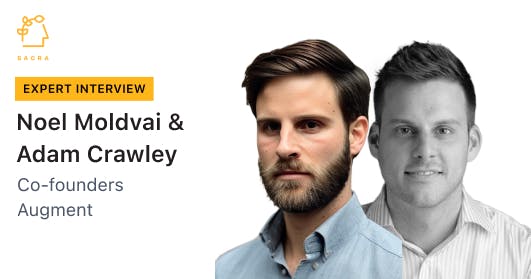Q&A with Balthazar de Lavergne and Mathias Pastor at Semper
 Conor Gleeson
Conor Gleeson

Background
Balthazar de Lavergne and Mathias Pastor are co-founders of Semper, which helps companies run recurring secondary transactions for employees and investors. We talked to Balthazar and Mathias to learn more about Semper and get their take on the state of the market for pre-IPO securities.
Questions
- Can you tell us a little more about yourselves and how the idea for Semper came about?
- The private market landscape in the U.S. seems supply-constrained. Companies don't necessarily want their stock trading hands so they introduce ROFRs and stock transfer restrictions that make it difficult to actually transact in secondary markets. What’s your take on the landscape?
- What does the transaction look like on Semper? How does the structure work?
- Is matching the demand with supply still manually done? Does it take a lot of phone calls to potential buyers, LPs? What does the buy-side demand look like?
- Is it just the marketplace or have you built the plumbing, the pipes, brokerage, settlement, and any sort of research infrastructure that goes into that?
- What’s your take on secondary trading as an asset class? What do you tell investors that might think that secondary is dead?
- What do you make of Tiger and others pulling term sheets from private deals? How’s the risk appetite in the current marketplace? Has the volume stayed consistent or maybe even picked up a bit?
- Are you seeing funds where companies are getting marked down or they're just unwilling to transact and print an uglier valuation?
- What do you think about synthetic derivatives, and calls and puts on private stock? Have you had any demand for those types of derivative products?
- Are the conversations you're having with these issuers competitive? Are you competing against Carta and similar platforms, directly?
- Is your set of buyers as equally interested in the $250 million market cap companies as they are unicorns? Are they just different profiles or risk appetites, or are people index investing across this?
- So far our speakers have focused only on the U.S.-based companies facilitating tenders or secondary programs. Is there any difference in how companies approach the conversation around standardized liquidity programs based on their geographical location?
- There's rights and preferences that investors enjoy in the U.S. for financing rounds. Is it mirrored in Europe? Do investors have a different appetite for common stock than European companies, given the way the governance of stocks works?
- Can you talk a little about the legislation and regulation for private company stock in Europe?
- With regard to the synthetic derivatives, a big component relevant to clients in the U.S., is the taxation angle. Do derivatives have a different sort of tax implication in Europe? What are the biggest tax burdens for employees or founders looking to sell or get liquidity?
- The conversations around equity are also very different in Europe. Do you see that trend changing? Are people beginning to think about equity the same way as American tech employees?
- Given how public markets are facing uncertainty, it seems natural that secondaries will pick up as companies need liquidity for employees. Are companies more receptive to giving investors access to financials and other helpful information as the secondaries pick-up?
- In the context of access to information, are there any disclosure requirements or practices in excess of what companies share in the U.S.? Are there any imperatives in the European market that might not exist here?
- Is it true that any information is helpful for buyers since they're used to not having a lot for starters?
Interview
Can you tell us a little more about yourselves and how the idea for Semper came about?
Balthazar: I’ve worked in the tech industry for the past 10 years. I was on the team that launched HelloFresh in the U.S. and then I worked in an accelerator program, investing in companies across Europe, some of which have become very successful.
In all these years, we’ve seen the trends that pushed us to create Semper. These are the same across the U.S. and Europe: the tech ecosystem is doing well, companies are staying private for longer, employees are owning more of the businesses they work for, and that’s creating different liquidity needs for stakeholders. That’s what led us to create Semper.
Mathias: I was working at the same early-stage accelerator as Balthazar and before that, I had a brief stint at a hedge fund. Prior to that, I tried my hand at building another company called Teech that looked at peer-to-peer tutoring.
With Semper, I'm rediscovering some of the joys of building a marketplace and more importantly, a team. At Teech, we were 12 at our peak. I aim to quickly eclipse that record and build an awesome team at Semper.
The private market landscape in the U.S. seems supply-constrained. Companies don't necessarily want their stock trading hands so they introduce ROFRs and stock transfer restrictions that make it difficult to actually transact in secondary markets. What’s your take on the landscape?
I'd say the landscape in Europe is pretty similar to the U.S. and companies mostly engage in these kinds of restrictions to protect themselves.
If you look at the secondary markets historically, pre-2000 bubble, it wasn't much of a problem—because either you didn't get equity or you’d have an IPO in a few years.
After the bubble, companies like Facebook and Google became flexible on letting employees transact, leading to the creation of SharesPost and SecondMarket. That backfired for Facebook when they had over 500 shareholders and had to go public, which then scared the Valley and the next generation of great startups —Airbnb, Pinterest, Uber, and so on.
Those companies made it a rule to block every secondary transaction, and so we saw the rise of platforms like Forge where you could do forward contracts, so the companies didn't really know that employees were selling.
Today, we see a maturing ecosystem where companies understand that they need to organize the market themselves and be at its center.
When talking to founders, what we realized is no one is really against secondary. They just don't want people trading with anyone. They want control over their investors, they want to keep the right incentives with their team members, and they don’t want to publicly share information.
What does the transaction look like on Semper? How does the structure work?
We convince management to work with us. Then, we ask employees how much they'd like to sell and at what price.
We market a block of shares to the institutional investors who bid and try to set the right price based on the information they have about the company. When we have both sides of the transaction, we clear the price that maximizes the volume, so it's not a tender offer. You don't start with a fixed price. That makes it lighter, regulatory-wise.
Is matching the demand with supply still manually done? Does it take a lot of phone calls to potential buyers, LPs? What does the buy-side demand look like?
It is for now. It’s still very early days for the Semper platform, so it's not like investors are logging into it every day to see what our latest deals are.
Some platforms or brokers, however, go the opposite way. They just try to find as much deal flow as possible, regardless of its quality, both in terms of the actual companies and the way in which they are assessed.
We're very strict about only working on opportunities initiated by the company. For now, it means that when we speak to the buyers, we go back to them every time we work with a new company. As time passes, we’ll sign more companies to work with, so that won't be the case anymore.
For anyone essentially looking for a single-name access to tech companies, Semper is the best place to be at. That’s where we're trying to go.
Is it just the marketplace or have you built the plumbing, the pipes, brokerage, settlement, and any sort of research infrastructure that goes into that?
A big part of this is where Sacra comes into play. Indeed, in private markets, most investors lack information. Weirdly, it's a market where insiders get much more information than anyone would get in public markets. If you’re an outsider, you get access to nothing.
As of today, 80% of volumes in the secondary market happen with absolutely no data on the business, which means that most of the volume goes towards the big stocks—SpaceX, and so on.
Clearly, there is a gap in both data and knowledge for most companies, and we want to really create some liquidity. For this, we have to partner with companies like Sacra that do high quality research. One day, we’ll aggregate a few other research firms that will be happy to share all of that with our investors. The infrastructure and the settlement is therefore something to be built.
Today, closing a transaction in the private markets takes an average of three months—that’s a big hurdle to creating liquidity. There’s a lot to be built to be able to actually settle transactions internationally for private companies. We’re yet to touch the beginning of this.
What’s your take on secondary trading as an asset class? What do you tell investors that might think that secondary is dead?
Volumes are picking up but investors are still quite unaware of how the asset class works. The only sophisticated people in the tech industry are the VCs, and they typically mostly do primary and target large ownerships. They're going to own the stock for many years, so that doesn't favor volumes, but other types of investors are certainly getting interested.
The hedge funds do primary, a lot of the specialized secondary funds, and some family offices. Soon, they will start having more tactical strategies where they might not hold the position for so long. We think there will be a whole bunch of different investors coming into the space. If there is more demand, there's going to be more supply, and today, people will wait to exit given no one offers any liquidity and the way their funds are structured.
What do you make of Tiger and others pulling term sheets from private deals? How’s the risk appetite in the current marketplace? Has the volume stayed consistent or maybe even picked up a bit?
Some of the more uncomfortable conversations that we've had are with companies that raised in October or November at pretty crazy multiples, and now, want to do a secondary for their employees at that same price. Part of our job is also to manage expectations with those companies. We're not an open marketplace, both on the buyer- and seller-sides, so the worst thing that we can do is to work with a company which enables their employee to sell and then, does not actually find any buyers. We have to be quite picky.
If you work with the right companies and have realistic expectations about what the price is going to turn out to be, overall, it will be okay. However, I’d definitely not be super confident to work with a company that raised four months ago at 500x ARR.
Are you seeing funds where companies are getting marked down or they're just unwilling to transact and print an uglier valuation?
So far we haven't really seen any brutal markdowns. The most standard things that we've seen have to do more with the fact that in our case, it tends to be the common stock that trades rather than the preferred.
It was the usual 10-20% that you'd expect from being lowered down in the liquidation preference stack. However, because of the way we work, a company can set bounds around the price. While we haven't been exposed to a situation where all the bids are below the bounds yet, once in a while, that might be the case.
What do you think about synthetic derivatives, and calls and puts on private stock? Have you had any demand for those types of derivative products?
To be honest, with the populations that we're speaking to, not so much. That’s because though we only work with professional investors, they’re typically in the early stages of their venture investing journey . They might have done a couple LP investments in VC funds, but usually they'll have made at most a handful of direct investments. So, they're still pretty far, from what I've seen, from demanding that.
Once we start transacting on larger blocks with professionals of the venture asset class or very sophisticated hedge funds, then maybe that'll emerge more often as funds look for ways to hedge some of their positions.
Are the conversations you're having with these issuers competitive? Are you competing against Carta and similar platforms, directly?
Carta is definitely the most serious form of competition that we have at this point on company-initiated programs. There are many technical reasons why companies are better off working with us, but it's true that if there is one kind of deal where it's tough for us to compete, it's U.S. companies with exclusively U.S. employees selling exclusively to U.S. investors. On that, and especially if it's on the tender offer product, Carta has great product-market fit.
With regard to international teams and smaller caps, we got feedback from the Head of Coverage at Carta, who said that they were focused on Series E and above. We work with companies as early as $250 million valuation. Since we go to slightly younger and more international companies, I don’t think we're competing much with Carta for now.
Is your set of buyers as equally interested in the $250 million market cap companies as they are unicorns? Are they just different profiles or risk appetites, or are people index investing across this?
You have a mix there. Overall, it'll always be easier to sell the unicorns. That being said, one of the reasons we still work with some of these smaller cap companies is because people who have been investing directly in venture for a couple years understand that if you want to make great returns, it's good to start investing a bit earlier.
It’s also because we're not in a one-off transaction business. If you're a broker and your goal is just to maximize short-term volume, then, you probably shouldn't be wasting your time with companies that are worth $250 million now.
Given we run recurring liquidity programs for companies, however, it's actually good to start pretty early because it gives us the opportunity to help the investors build the conviction they need to progressively build up positions.
We might go with the company when it's worth $250 million and then come back a year later and see it’s worth $400 million. We may come back the second year and it's worth $600 million. So, even if they said no at $250 million, at least at one point they did the work to understand what they needed to see in that business before investing. I'd say that's one of the big edges that we have vs. all of the one-off transactions.
So far our speakers have focused only on the U.S.-based companies facilitating tenders or secondary programs. Is there any difference in how companies approach the conversation around standardized liquidity programs based on their geographical location?
What we've observed is that, since you didn't have that many companies to trade five to six years ago in Europe, platforms like SecondMarket or SharesPost didn’t give companies quite the same scare. Until recently, you didn't have these kinds of clauses you mentioned, so it was actually easier to do secondaries in Europe.
Now, you have a couple of these consumer-to-consumer marketplaces that are popping up, where individual employees can sell stock to retail investors. Ironically, those clauses are now starting to emerge in company bylaws. That’s beneficial to us because they highlight the discussion around employee liquidity. That never really existed in Europe before because no one really became rich thanks to equity.
Today, with these marketplaces coming up, people realize they can sell. The company, in turn, flips out because they're losing control.
We are a pretty immediate solution to both of those problems. I'd say the education cycle is much faster in Europe because we're just kind of leapfrogging all the stuff that was learned over the course of 10 years in the U.S.
It's becoming more complicated to do transfers unless you have company approval. That's how we position ourselves. In terms of structured liquidity events, the structure is still pretty similar to what you see in the U.S., meaning that most of the secondaries have been bundled with the primary rounds, where their lead VCs actually facilitate $5, $10, or $20 million for founders and the employees.
However, some companies do un-bundle the two dynamics to make it more predictable for employees and actually have more competitive compensation packages. On that front, trends in the U.S. and Europe are pretty similar. The talent war is quite intense, and offering more liquid stocks to employees in the private market is very beneficial to attract the right people.
There's rights and preferences that investors enjoy in the U.S. for financing rounds. Is it mirrored in Europe? Do investors have a different appetite for common stock than European companies, given the way the governance of stocks works?
It's pretty similar, except that the investors are less educated about the tech ecosystem. So they haven't seen the parallel materialize as much as you may have in the U.S., meaning that they're typically more concerned about downside protection than some of their counterparts in America.
They're not always comfortable buying common stock, but we see the most sophisticated asset managers have the belief that everything converges if the company's a success. However, under specific restrictions and the structure of the preference stock, I'd say, it's very similar.
Can you talk a little about the legislation and regulation for private company stock in Europe?
We’ve got the equivalent of America’s SEC and FINRA in each country. You only need to check, depending on the level of regulatory approval you have, whether these agreements are passportable or not in all the EU member countries.
What we are aiming for is something that is passportable across those 27 countries. In the UK, you need a separate setup to actually be able to operate, but for now, the country hasn't diverged from the standards present in continental Europe.
With regard to the synthetic derivatives, a big component relevant to clients in the U.S., is the taxation angle. Do derivatives have a different sort of tax implication in Europe? What are the biggest tax burdens for employees or founders looking to sell or get liquidity?
I’m not an expert on the derivatives front, but we’ve heard it's very difficult for most employees.
There are different sets of complications. Depending on the geography you're in and the type of instrument you get from the company you work at, you get taxed either upon the grant, upon vesting, or at exit. You’re taxed differently for each.
When the taxation happens upon grant or vesting, typically, the company you work for informs you. It doesn't mean that they give you the money or you have the money to actually pay the taxes, but at least they're there to tell you how it should happen.
At the exit, it's not so much the amount of tax that you pay that is problematic for people as much as knowing how to file them and when to pay them. Since it's complicated, most of the employees have no clue how to optimize for it. It's not as obvious as in the U.S. where, you know you can exercise early, then, you pay less taxes at exit. In Europe, it's slightly more complex.
The average European employee is a lot less sophisticated when it comes to approaching their equity than the average U.S. employee. In most startups, the equity's still seen as a lottery ticket/bonus rather than a core part of compensation. So, a lot of the financial instruments that exist in the U.S. for employees to make the most of their equity don't exist at all in Europe. There's no European SecFi or anything like that.
The conversations around equity are also very different in Europe. Do you see that trend changing? Are people beginning to think about equity the same way as American tech employees?
Yes, 100%. It’s progressing super fast. We see it in our conversations with employees. We have a grid where a lot of people try to top their equity stakes. I think it means that we're hiring good people, but in general, it seems to be improving. It's just very hard to believe that equity's worth anything until you've seen other people get rich from it.
In Europe, those companies are just attaining maturity. So, yes, it is starting to become a much more common and important part of conversations and hiring.
Given how public markets are facing uncertainty, it seems natural that secondaries will pick up as companies need liquidity for employees. Are companies more receptive to giving investors access to financials and other helpful information as the secondaries pick-up?
Definitely. The volatility in the public markets pushes companies to let their employees de-risk a little while they’re still at the top, potentially knowing they will go down a bit.
When they specifically organize the secondaries for their employees, they have an interest in maximizing the price. For that, you need to maximize the number of investors that are interested. Then, the more information you share, the easier it is to get investors to actually bid. We see companies being okay with sharing information, but only in certain frameworks where they can actually control who sees what.
In the context of access to information, are there any disclosure requirements or practices in excess of what companies share in the U.S.? Are there any imperatives in the European market that might not exist here?
It's a pretty similar framework. Companies decide based on the reputation of the people they speak with. In our case, we only work with regulated intermediaries, mainly private banks, where we know that the information is safe. That's enough for companies to be okay with sharing something.
In most of the transactions that happen, we don't really require full access to due diligence, just a last round deck, updated numbers, and waterfall. If investors get more than that, they're super happy, because it's something they usually don't get.
Is it true that any information is helpful for buyers since they're used to not having a lot for starters?
Yes. The biggest question is obviously around pricing. If the secondary happens three months after Sequoia invests at the same price, nobody has problems paying that price.
If it’s a year later and you have no clue how the company performed, then of course, it's much more problematic. Those companies probably won't raise every six, nine, or 12 months for the next 10 years. The pricing will have to be done by people that have some vision and view into the business, and companies understand that if they want more frequency, they'll have to share something.
Disclaimers
This transcript is for information purposes only and does not constitute advice of any type or trade recommendation and should not form the basis of any investment decision. Sacra accepts no liability for the transcript or for any errors, omissions or inaccuracies in respect of it. The views of the experts expressed in the transcript are those of the experts and they are not endorsed by, nor do they represent the opinion of Sacra. Sacra reserves all copyright, intellectual property rights in the transcript. Any modification, copying, displaying, distributing, transmitting, publishing, licensing, creating derivative works from, or selling any transcript is strictly prohibited.




